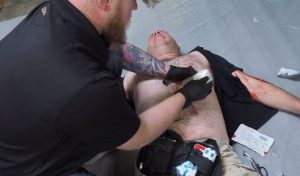What is Trauma Medicine M.A.R.C.H. and How Does It Work?

The Term “MARCH” gets thrown around a lot, so in this article I’ll go over what it is, and how to use it effectively to come out on top when you are taking care of someone with a trauma emergency.
Emergencies are stressful for everyone, and I doubt anyone would argue that, so little tricks to remember things is always helpful.
M.A.R.C.H. is one of those little trick medics use to help keep them on the right track. It can quickly get confusing trying to remember what wounds are the most important and in what order they should be treated in.
You may have a life-threatening wound, like a developing tension pneumothorax, but that is a less pressing concern then a bleeding femoral artery would be. Using MARCH will help you to remember that and stay on task.
M is for Massive Bleeding
You might be aware bleeding is a preventable death and how quickly someone can bleed to death needs no further discussion. But in case you didn’t know, a person can bleed to death from a femoral artery in 2:30-3:00 minutes.
M is first in the acronym because it’s what will kill the casualty quickest. If the wound is on an extremity, it is quickly addressed with the application of a tourniquet (TQ). If you witness a victim losing a worrying amount of blood, don’t be afraid to apply the TQ quickly as your first course of action.
If the bleeding is anywhere else, however, the only other options are wound packing and/or direct pressure.
A is for Airway
Blood carries oxygen around the body, so since we have already addressed life threatening bleeding with the “M,” now we need to be sure there is a clear path for O2 to enter the body so it can be carried to the body’s tissues and keep our casualties alive.
In trauma medicine it isn’t unheard of for a casualty to take sever facial trauma which blocks the airway and preventing the flow of oxygen. It’s also common for the unconscious victim to vomit. Being unconscious, they may choke on the vomit and ruin all the hard work we went to with the TQ.
A Nasal Pharyngeal Airway (NPA) may help to keep the airway open of a casualty who’s lost consciousness, but we also want to make sure we’re positioning the casualty on their sides (Recovery Position) so blood and vomit is not aspirated into the lungs (but only if we aren’t worried about spinal damage.)
R is for Respiration
Bleeding has been controlled?
Check
Airway is clear?
Check
Can the casualty breath?
Now we check to make sure the casualty can move air in and out of their lungs. Expose the chest so you can get a good look and ensure there isn’t trauma.
If we find any wounds, from neck to navel on the trunk of the victim, we place a seal on these sucking chest wounds to prevent a pneumothorax from developing.
If the casualty is alert and having difficulty breathing, they may want to position themselves in a way that makes it easier for them to breath. If they want to sit up or lean over to breath better, we should let them and make it as easy as possible to move O2 in and out.
C is for Circulation
Here’s a moment to go back over your casualty, from head to toe and double check to be sure you haven’t missed any dangerous wounds, and that all your TQs, wound packing and chest seals are still doing their job and have been applied correctly the first time.
Carefully inspect your casualty starting at the head and working your way down. Be thorough and don’t forget to roll them over to inspect the victims’ back for wounds that may need attention.
H is for Hypothermia
Trauma victims are notorious for not being able to keep themselves warm. A victim with a low body temp will have a much-reduced chance for survival. Since we have used all of MARCH to address the things that can kill them for the moment, now we need to increase the victims’ odds of survival by keeping them warm.
Survival blankets are small, cheap and help when you have nothing else, but look for other ways as well to keep the victims’ temperature up.
If you’d like to learn more about how to do the things described in this article, check out our free online course, Emergency Trauma Response.

Great information! we are forming a church safety/security team and this info will be very useful!